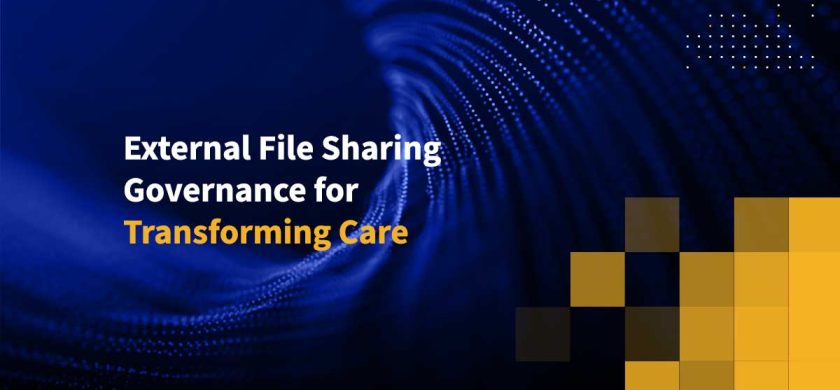
External File Sharing Governance for Transforming Care
External file sharing governance is challenge for many healthcare organizations (HCOs), but it’s a challenge they need to address to deliver the best possible care while ensuring compliance with data privacy and data security regulations like HIPAA.
Here’s why.
It is becoming increasingly critical for providers to have full control and visibility into patient health information (PHI) and how it is shared externally with specialists, researchers, other facilities or insurers. The ramifications of not knowing where PHI is stored, who has access to it, or what’s being done with it, does more than denote poor external file sharing governance. It can lead to a data breach or a compliance violation, or both.
External File Sharing Governance Is an Operational Requirement
There are a number of reasons why organizations need to practice external file sharing governance and they pertain to sharing data securely with external organizations or users. Consider the scenario of a doctor collaborating with a specialist on a particular case, a remote care facility transferring a patient (and her records) to a hospital, or a medical staff member sending a patient’s treatment summary to his insurer.
But finding the data to send is often a challenge. A single patient’s information is likely scattered across a modern-day hospital. EHR systems like Epic and Cerner, ECM systems like SharePoint Online and Open Text, CRM systems like Salesforce and SugarCRM, ERP systems like Oracle and SAP and others all hold patient data. And new systems and devices are constantly being added.
External File Sharing Governance Requires Internal Control over Data
Connecting these systems is one challenge; accessing the information on these systems is another. HIPAA requires that healthcare organizations know precisely where patient information is stored and who has access to it (hint: not everyone should have access to patient information).
Unauthorized access – whether it’s a hacker, a staff member who falls victim to a phishing attempt or nosy administrator curious about a celebrity patient – are all real threats to hospitals and their file sharing governance efforts. Data breaches and subsequent HIPAA violation fines are on the rise. There is no indication that the problem is going to get better anytime soon.
But it’s not all doom and gloom. Healthcare CIOs, CISOs, and IT departments have a prime opportunity to capture and leverage all the data being generated to achieve the highest levels of security, demonstrate compliance and maintain existing workflows. This includes external file sharing governance.
Internal file access governance and external file sharing governance can give healthcare IT organizations the visibility and control they need to keep PHI safe and their organizations compliant with HIPAA and HITECH.
To learn how proper external file sharing governance is essential—and possible—to maintain patient privacy as well as ensure regulatory compliance, schedule a custom demo of Kiteworks today.
Frequently Asked Questions
HIPAA compliance is the adherence to the federal standards set forth in the Health Insurance Portability and Accountability Act (HIPAA) of 1996. This includes requirements on the handling and protection of patient data, as well as patient privacy.
Protected health information (PHI) is any individually identifiable information related to a patient’s physical or mental health condition, the provision of healthcare, or payment for healthcare services. This includes names, addresses, Social Security numbers, medical records, and any other confidential information associated with a patient’s health.
Failure to adhere to HIPAA compliance regulations can result in civil or criminal penalties. Civil penalties range from $100 to $50,000 per incident. In cases of willful neglect, criminal penalties can lead to up to 10 years of imprisonment.
To meet HIPAA compliance requirements, your technology must offer secure data storage, access control, user authentication, encryption, audit logging, and activity monitoring. It should also offer the ability to restrict access to data based on the user’s role and authorize individuals to have access only to the data they need.
Adhering to HIPAA compliance regulations can help protect patient data, increase trust in the healthcare system, reduce healthcare costs, and improve patient safety. It can also protect your organization from legal and financial repercussions.
To ensure your organization is HIPAA compliant, you should work with a qualified third-party vendor that can help you audit your data and processes, develop a comprehensive information security plan, and train your staff on best practices for data security and patient privacy.
Kiteworks provides organizations with the tools and features necessary to ensure their data is secure and private and remains compliant with HIPAA. The Kiteworks Private Content Network enables organizations to demonstrate compliance with HIPAA by unifying, controlling, tracking, and securing sensitive PHI data exchanges—email, file sharing, managed file transfer, web forms, and APIs. Kiteworks offers role-based access control to ensure users are only granted access to the data they need to perform their job, and helps organizations monitor and control data access in accordance with HIPAA. It also keeps organizations in compliance with HIPAA through its automated audit logging capabilities, as well as providing on-demand data destruction capabilities and comprehensive reporting capabilities. These features help organizations maintain a clear view of their data security posture and ensure that patient data is only being accessed by authorized individuals and is securely and permanently deleted when no longer needed.
Additional Resources
- Blog Post What is the Best Managed File Transfer Software for Shopping?
- Blog Post Secure File Sharing
- Blog Post What is Enterprise File Sharing?
- Blog Post What are Business File Sharing Solutions?
- Blog Post [HIPAA Compliant Cloud Storage] Secure & Private Storage
